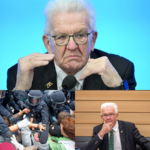Formula 1, a sport once defined by the thunderous roar of its engines and the raw, untamed personalities of its drivers, is facing an identity crisis. A growing chorus of long-time fans and insiders are sounding the alarm, arguing that the sport has traded its soul for a fleeting moment in the social media spotlight. The F1 of today, they say, is a pale imitation of its former self, a sanitized, overly commercialized spectacle that has lost touch with its roots. This is the story of how Formula 1, in its relentless pursuit of a new, younger audience, may have alienated its most devoted followers and, in the process, lost the very essence of what made it great.

The heart of the issue, for many, lies in the sound of the sport itself. The visceral, ear-splitting scream of the old V12, V10, and V8 engines was more than just noise; it was the sport’s anthem, a symphony of power and passion that resonated deep within the chest of every fan. Think of Michael Schumacher’s Ferrari V10, a wailing beast of a machine that could send shivers down your spine. That sound was the very embodiment of Formula 1’s untamed spirit. But in 2014, in the name of “road relevance” and a misguided attempt to appear more environmentally conscious, the sport ripped out its own heart, replacing these legendary power units with quiet, characterless V6 turbo-hybrids. The roar was gone, replaced by a sound that many have derisively compared to a vacuum cleaner. This was the first, and perhaps most significant, sign that Formula 1 was willing to sacrifice its core identity for a more palatable, mainstream image.
The sanitization of the sport didn’t stop with the engines. The drivers, once a motley crew of rebels, playboys, and mavericks, have been slowly but surely molded into polished corporate spokespeople. The days of James Hunt’s wild antics or Kimi Räikkönen’s refreshingly blunt, no-nonsense attitude are long gone. Today’s drivers are media-trained to within an inch of their lives, their every word and action carefully scrutinized by a legion of PR professionals. The FIA’s increasingly strict enforcement of rules, from a crackdown on driver jewelry to a code of conduct that discourages any display of genuine emotion, has further stifled their personalities. The result is a grid of largely interchangeable, brand-safe athletes, a far cry from the larger-than-life characters who once made the sport so compelling.
Then came Netflix’s “Drive to Survive,” a docuseries that, while undeniably successful in attracting a new, younger audience to the sport, has also been heavily criticized for its use of manufactured drama and out-of-context radio messages. The show has, in many ways, transformed Formula 1 into a reality TV show, where the on-track action is often overshadowed by interpersonal conflicts and exaggerated rivalries. While the series has undoubtedly boosted the sport’s popularity, particularly in the United States, it has also created a new generation of fans who are more interested in the off-track soap opera than the intricacies of racecraft. This has led to a fundamental shift in the sport’s focus, with an increased emphasis on social media engagement and creating “content” at the expense of genuine sporting competition.

This shift in focus has been accelerated by Liberty Media’s acquisition of Formula 1 in 2017. The American company has made no secret of its desire to reshape the sport in “America’s image,” a move that has been met with a great deal of skepticism from traditional fans. The introduction of sprint races, a concept borrowed from American motorsports, has been particularly controversial, with many arguing that it dilutes the significance of the main Grand Prix and the achievement of pole position. The addition of new races in Miami and Las Vegas, while undoubtedly lucrative, has also been criticized for prioritizing celebrity spectacle and artificial glamour over the quality of the racing. The disastrous first practice session at the inaugural Las Vegas Grand Prix, where a loose manhole cover caused significant damage to one of the cars, was seen by many as a symbol of the new F1’s “style over substance” approach.
As new, more “entertaining” venues are added to the calendar, the sport’s traditional heartlands are being squeezed out. Iconic European circuits like Spa-Francorchamps, the German Grand Prix, and the French Grand Prix have either lost their place on the calendar or are in constant danger of doing so. These are the tracks that have been a part of Formula 1’s DNA for decades, the places where legends were made. Their loss represents a further erosion of the sport’s heritage and a disconnect from its roots.
The cars themselves have also become a source of discontent. The 2022 regulations, and the upcoming 2026 rules, have led to a situation where the cars are becoming increasingly standardized, with many fans complaining that they all look the same. The regulations have been so restrictive that they have stifled innovation and reduced the areas where teams can differentiate themselves. The result is a sport that is in danger of becoming a “spec series,” where the cars are all but identical and the outcome of the races is determined more by strategy and luck than by engineering prowess.

Perhaps the most troubling aspect of Formula 1’s evolution is its increasing inaccessibility to the average fan. The path to a seat in Formula 1 has become, for many, a financial transaction rather than a sporting achievement. The rise of so-called “pay drivers,” who bring significant financial backing to a team in exchange for a seat, has led to a situation where talent is no longer the sole determining factor in a driver’s career progression. This has not only devalued the achievement of reaching the pinnacle of motorsport but has also created a perception that the sport is no longer a meritocracy.
At the same time, the cost of attending a Grand Prix has skyrocketed, pricing out the working-class racing enthusiasts who have traditionally been the sport’s most passionate and dedicated fanbase. The grandstands are now increasingly filled with corporate guests and VIPs, who are often more interested in the social aspect of the event than the racing itself. This has led to a sterile, corporate atmosphere at many races, a far cry from the passionate, almost tribal, atmosphere of years gone by.
In its quest for global expansion and a new, more casual audience, Formula 1 has risked losing its very soul. The sport has become a victim of its own success, a global entertainment brand that has forgotten what made it special in the first place. The challenge for Formula 1 now is to find a way to balance its commercial ambitions with its sporting integrity, to attract new fans without alienating its traditional base. It needs to remember that it is, first and foremost, a sport, not just a TV show. It needs to bring back the noise, the passion, and the authenticity that once made it the greatest spectacle on Earth. If it doesn’t, it risks becoming a hollow, soulless imitation of its former self, a cautionary tale of a sport that sold its soul for a Netflix meme.
News
Die Sprache der Liebe: Wie Bushido und Anna-Maria Ferchichi ihre 15-jährige Ehe in der Paartherapie retteten – Das emotionale Geständnis der „Liebessprachen“-Krise
Die Ehe von Bushido und Anna-Maria Ferchichi gehört seit Jahren zu den am meisten beachteten Partnerschaften der deutschen Öffentlichkeit. Sie…
Tanzwunder im siebten Monat: Renata Lusin tanzt hochschwanger! Das emotionale Comeback und die bewegende Geschichte des “Campingbabys”.
Die Nachricht schlug in der deutschen Medienlandschaft ein wie ein funkelnder Diskokugel-Blitz: Renata Lusin, die charismatische und stets energiegeladene Profitänzerin,…
Antonia Hemmer enthüllt das bestgehütete Geheimnis: „Er ist derjenige, für den ich gebetet habe“ – Ein Beweis von Liebe, Schutz und Selbstbestimmung
Es war ein einziger digitaler Atemzug, der die gesamte Reality-TV-Welt in ihren Bann zog und die Gerüchteküche zum Überkochen brachte….
Schock-Nachricht beim TV-Comeback: Helene Fischer kündigt Mega-Pause für ihre große Stadion-Tour an!
Die Schlagzeilen über Helene Fischer sind meist ein Spiegelbild von Superlativen: Rekorde, ausverkaufte Stadien, atemberaubende Spektakel. Doch nach der Geburt…
Anna Heiser: „Was sich wie ein Ende anfühlte, war unsere Rettung“ – Die dramatische Wahrheit hinter Ehekrise, Existenzangst und dem radikalen Neuanfang
Wenn Anna Heiser (35) heute mit ihrem Mann Gerald und ihren Kindern Leon (4) und Alina (3) glücklich um den…
Zwischen Blitz-Einsatz und Glamour-Verwandlung: Katja Burkards ungeschminkter Sprint zur Rettung der RTL-Show Denn sie wissen nicht, was passiert
Der Samstagabend ist in der deutschen Fernsehlandschaft traditionell die Hochburg der großen Unterhaltung, der Ort, an dem sich TV-Ikonen in…
End of content
No more pages to load












